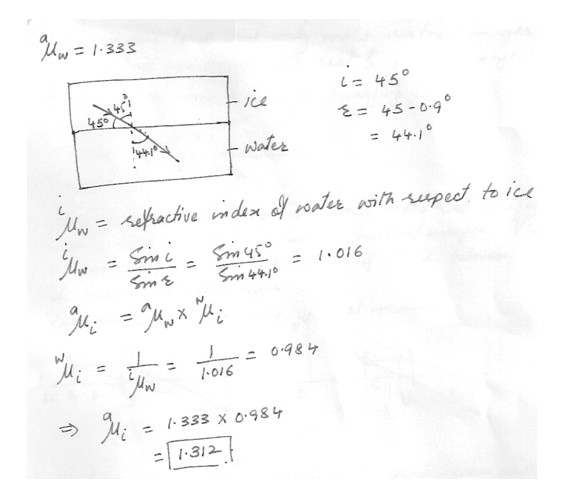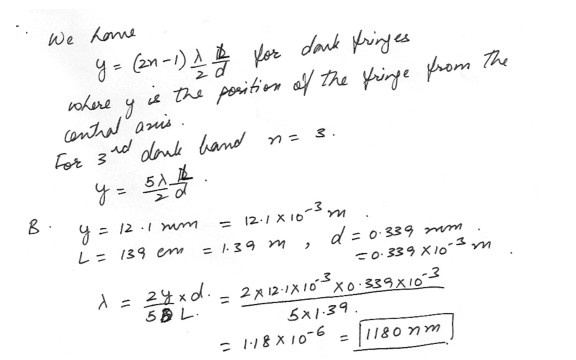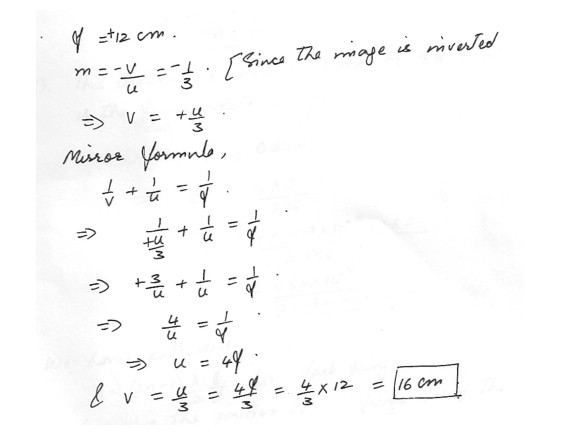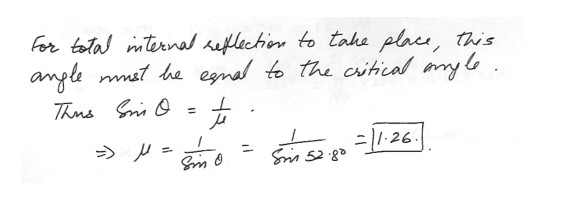Physics Ray Optics Level: High School
Ray Optics
This problem assumes symmetric about rotation and shallow curvature for lenses . Use ray diagrams to justify the answer .Is there only one type of lens that can only make virtual images ?
Any type that can only make real images ?
Any type that always gives magnification greater than one ?
Any type that gives magnification less than one ?

Physics Ray Optics Level: High School
Wave Optics
The interference patterns show are from sending a laser beam through a double slit .(a) suppose both were made with laser light of the same wavelength , but the distance between slits was different . Which pattern was made with wider spacing explain .
(b) Now imagine instead that they both were made with the same slit spacing but with different wavelengths of light . Which one was made with the shorter wavelength of light ? Explain .

Physics Ray Optics Level: High School
Ray Optics
sunlight passes through the layer of ice on the surface of a pond and then onto the liquid water below . In the ice the rays are at an angle of 45 degrees with respect to horizontal , and at the ice-water interface they are deflected down by .9 degrees . The index of refraction of water is 1.333 . What is the index of refraction of ice ?
Physics Ray Optics Level: High School
Wave Optics
A) Consider a horizontal plane of thin film with thickness t . This film is located between air and water . The index of refraction of film is 1.5 and the index of refraction of water is 1.33 . The wavelength of incident wave in the air is lambda and its frequency in air is f = c/lambda. Find the wavelength of the light in the water .B) The frequency of the light in water will decrease , increase or stay the same ?

Physics Ray Optics Level: High School
Wave Optics
A) The slits in a Young”s Interference apparatus are illuminated with monochromatic light of wavelength lambda . The third dark band is y from the central axis . The two slits are d apart and the screen is L away from the slits . We want to calculate the wavelength of the light used . What is y in terms of lambda ., d, and L ?B) Compute the wavelength in this experiment if y = 12.1 mm , L = 139 cm and d = .339 mm . Answer in units of m .

Physics Ray Optics Level: High School
Wave Optics
A) Two slits are illuminated by a 479 nm light . The angle between the zeroth order bright band at the center of the screen and the fourth-order bright band is 21.1 degrees . If the screen is 162 cm from the double slit , how far apart is this bright band from the central peak ?B) What is the distance between the two slits?
Answer in units of mm .
Physics Ray Optics Level: High School
Ray Optics
Two lenses are combined to form a compound lens . One of the lenses has a power of 12.8D and the other has a power of -5.94 D . Find the focal length of the resulting lens . Answer in units of cm .
Physics Ray Optics Level: High School
Ray Optics
A concave mirror has a focal length of 12cm . what is the position of the resulting image if the image is inverted and 3 times smaller than the object ? Answer in units of cm ?
Physics Ray Optics Level: High School
Ray Optics
A light ray passes downward into a block of transparent plastic with an angle of incidence of theta = 52.8 degrees . If total internal reflection is to occur when the light strikes the left edge of the block at interface b , what is the index of refraction of the plastic ?
Physics Ray Optics Level: High School
Wave Optics
If the apparatus for a Young’s double slit experiment is completely immersed in water will the spacing of he interference fringes (i) increases , (ii)remain the same (iii) decrease . Why ? , What would the lateral displacement in exercise in the above question if the entire system were immersed in still water ?
Physics Ray Optics Level: High School
Wave Optics
Monochromatic light passes through two narrow slits and forms an interference pattern on a screen .(a) If the wavelength of light used increases will the distance between the bright fringes(i) increase (ii) decrease (iii) remain the same , why ?
(b) If the slit separation is 0.25 mm , the screen is 1.5m away from the slits , and light of wavelength 680nm is used , what is the distance from the center of the central maximum to the center of the third order bright fringe ?

Physics Ray Optics Level: High School
Two thin lenses are placed 4.00 cm apart . The first lens is ca concave meniscus with radii of one third and one half centimeters , the second lens is a symmetric double convex lens with radii of one quarter centimeter . An object 2.00 cm high is placed 6.00 cm in front of the first lens . Determine the image location , image height and orientation by .(a) direct measurement on an accurate ray tracing .
(b) geometric analysis of the ray diagram (that is looking at triangles)
(c) use of the thin lens equations

Physics Ray Optics Level: High School
Light with a wavelength of 600 nm (in vaccum) reflects horizontally from a vertical soap film . The force of gravity causes the soap film to acquire the shape of a very thin wedge (exaggerated in the figure at “click here”) when viewed from the side . The upper edge of the film appears black . Alternating horizontal bright and dark bands cover the film in such a way that the lowest edge of the film is the sixth bright band. The film is 2.75 cm long . The index of refraction of the soap film is 4/3 .a) Explain why light reflected from the front and back surface of the film create these bright and dark bands . In your answer explain why the uppermost edge is dark .
b) Determine the angle of the wedge .

Physics Ray Optics Level: High School
A glass hemisphere of index 1.5 and radius R has a mirror surface on its flat face . A small object of height h is located on the axis of the hemisphere at a distance of 2R from the vertex as shown in the figure at “click here”(a) Determine the location of the final image .
(b) Determine the orientation and magnification of the final image
(c) Draw a ray diagram showing the formation of the final image . In this construction use a ray directed to the centre of he hemisphere and another which is incident at the vertex of the hemisphere .

Physics Ray Optics Level: High School
Semiconductor
An ideal dfb laser diode has a threshold current of 12 mA and a slope efficiency of 0.3 mW/mA at room temperature . Sketch the light (optical output power) versus drive current for this device at room temperature . How much optical power is emitted at a drive current of 32 mA ?
